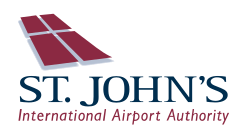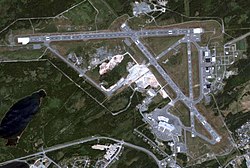St. John's International Airport
St. John's International Airport | |||||||||||||||||||
|---|---|---|---|---|---|---|---|---|---|---|---|---|---|---|---|---|---|---|---|
 | |||||||||||||||||||
 | |||||||||||||||||||
| Summary | |||||||||||||||||||
| Airport type | Public | ||||||||||||||||||
| Owner | Transport Canada[1] | ||||||||||||||||||
| Operator | St. John's International Airport Authority Inc. | ||||||||||||||||||
| Serves | St. John's, Newfoundland and Labrador | ||||||||||||||||||
| Location | St. John's, Newfoundland and Labrador | ||||||||||||||||||
| Elevation AMSL | 461 ft / 141 m | ||||||||||||||||||
| Website | www.stjohnsairport.com/ | ||||||||||||||||||
| Map | |||||||||||||||||||
 | |||||||||||||||||||
| Runways | |||||||||||||||||||
| |||||||||||||||||||
| Statistics (2010) | |||||||||||||||||||
| |||||||||||||||||||
Sources: Canada Flight Supplement[2] Environment Canada[3] Movements from Statistics Canada[4] Passengers from Airports Council International[5] | |||||||||||||||||||
St. John's International Airport (IATA: YYT, ICAO: CYYT) is an international airport located 3 NM (5.6 km; 3.5 mi) northwest of St. John's, Newfoundland and Labrador, Canada that serves the St. John's Metro Area and the Avalon Peninsula. The airport is part of the National Airports System, and is operated by St. John's International Airport Authority Inc.[2]
The airport is classified as an airport of entry by NAV CANADA and is staffed by the Canada Border Services Agency. CBSA officers at this airport currently can handle aircraft with no more than 165 passengers, however they can handle up to 450 if the aircraft is unloaded in stages.[2]
History
Concern was expressed as early as September 1939 in the Canadian Parliament for the security of Newfoundland (which was not yet a part of Canada) in the event of a German raid or attack.[6] It was felt that a permanent airfield defence facility was needed and as a result discussions were carried out among Canada, Newfoundland and the United Kingdom during 1940. In late 1940 the Canadian Government agreed to construct an air base near St. John's.[6] Early in 1941, Canadian Prime Minister William Lyon Mackenzie King informed Newfoundland Governor Sir Humphrey T. Walwyn of the intended location in Torbay.[6] Newfoundland agreed, stipulating, however, that Canada was to assume all expenses and that the aerodrome not be used for civil purposes without first receiving Newfoundland's permission. The Canadian Government agreed, and in April 1941 McNamara Construction Company began construction on the runway.[6] At a cost of approximately $1.5 million, a pair of runways, taxiways, aprons, hangars and other facilities were built and in operation by the end of 1941. The Royal Canadian Air Force (RCAF) officially opened Torbay Airport on December 15, 1941.[6] It was jointly used by the RCAF, Royal Air Force (RAF), and the United States Army Air Corps until December 1946.[6]

On October 18, 1941, three American B-17 Flying Fortress and one RCAF Digby made the first unofficial landing on the only serviceable runway available.[6] Later that month a British Overseas Airways Corporation B-24 Liberator en route from Prestwick, Scotland, to Gander, made the first officially sanctioned landing during a weather emergency.[6] The first commercial air service at the facility went into operation on May 1, 1942 with the arrival at Torbay of a Trans-Canada Air Lines Lockheed Lodestar aircraft with five passengers and a three-member crew on board. The first terminal building at the site was constructed in 1943. The small wooden structure was replaced by a larger brick building in 1958.[6]
Although the airfield was not used as much as Argentia, Gander, Stephenville and Goose Bay Airports in the movement of large numbers of aircraft to England, it was still quite busy.[6] The Royal Air Force had its own squadron of fighters, surveillance and weather aircraft stationed there. The RCAF personnel strength on the station during the peak war years was well over 2000. Through an agreement between the US, Canadian and Newfoundland governments early in 1947, the United States Air Force (USAF) took over the use of the airport facilities and utilized about ten of the buildings located there.[6] The US Military Air Transport Service (MATS) needed Torbay Airport in order to complete its assigned mission at that time. Maintenance of the airport and facilities was done by the Canadian Department of Transport.[6]
On April 1, 1946, the airport became a civilian operation under the jurisdiction of the Canadian Department of Transport. Confusion was caused by the presence of American military personnel at a civilian airport operated by the Canadian government in a foreign country.[6] Consequently on 1 April 1953 control was turned back to the Department of National Defence. On April 15, 1953 the RCAF Station at Torbay was reactivated and RCAF personnel started to move in and began providing the necessary administration and operation of the facility to support the mission of its co-tenant, the USAF.[6] In early 1954 a rental agreement was signed between the USAF and the RCAF and the USAF acquired use of additional buildings.[6]
The control tower originally constructed during the war burned down in an extensive fire at the airport on March 17, 1946, which caused $1.5 million worth of damage.[6] Construction was not begun on a new tower until 1951; it was opened in June 1952. A new Tower/Communications Building replaced that structure in March 1976.[6] The tower was equipped with radio navigation and landing aids including precision approach radar, non-directional beacon and VHF omni-directional range.[6]
The Transport Department maintained control over the terminal building. The facility remained RCAF Station Torbay until April 1, 1964, when it was returned to the jurisdiction of the Transport Department under the name St. John's Airport.[6]
In 1981 the terminal building housed the offices of the airport manager and staff. There were ticket offices for Eastern Provincial Airways, Air Canada, Gander Aviation and Labrador Airways, a large waiting area, a secure departure lounge, a self-serve restaurant, a licensed lounge, a number of food concessions and car rental facilities.[6] In 1981 a small museum was prepared to house the story of aviation in Newfoundland and related memorabilia.[6]
The airport underwent a $50 million renovation in 2002. The air terminal was completely renovated, expanded and modernized by architect John Hearn to meet the standards of other airport terminals its size across North America. The airport has undergone more renovations since then and plans are in place to prepare 300 acres (1.2 km2) of land to build an industrial park adjacent to the airport.[7][8]
The airport has been designated as one of five Canadian airports suitable as an emergency landing site for the Space Shuttle.
Airlines and destinations


Note: † denotes charter operators and their destinations
| Airlines | Destinations |
|---|---|
| Air Canada | Halifax, Montréal-Trudeau, Ottawa, Toronto-Pearson Seasonal: London-Heathrow |
| Air Canada Express operated by Exploits Valley Air Services | Deer Lake, Gander |
| Air Canada Express operated by Jazz Air | Goose Bay, Halifax |
| Air Saint-Pierre | Saint-Pierre |
| Air Transat † | Seasonal: Varadero |
| CanJet † | Seasonal: Cancun, Holguin, Puerto Plata, Punta Cana, Varadero |
| Porter Airlines | Halifax, Ottawa, Toronto-Billy Bishop |
| Provincial Airlines | Blanc Sablon, Deer Lake, Goose Bay, St. Anthony, Stephenville, Wabush, Churchill Falls |
| Sunwing Airlines † | Seasonal: Montego Bay [begins March 18 2012], Punta Cana, Toronto-Pearson, Varadero |
| United Express operated by Shuttle America | Newark |
| WestJet | Halifax, Toronto-Pearson Seasonal: Calgary, Orlando[9] |
Helicopter service
| Airlines | Destinations |
|---|---|
| CHC Helicopter | charter |
| Cougar Helicopters | Hibernia, Terra Nova, SeaRose, Hebron-Ben Nevis |
| Universal Helicopters | charter |
Fixed base operators (FBOs)
The following fixed base operators are based at St. John's International Airport:
See also
{{{inline}}}
References
- ^ Airport Divestiture Status Report
- ^ a b c Canada Flight Supplement. Effective 0901Z 16 July 2020 to 0901Z 10 September 2020.
- ^ Synoptic/Metstat Station Information
- ^ Total aircraft movements by class of operation — NAV CANADA towers
- ^ Airport Traffic Reports
- ^ a b c d e f g h i j k l m n o p q r s t u "A History of the Airport". St. John's International Airport. Retrieved 2011-01-28.
- ^ "Ready for Takeoff St. John's airport preps for another expansion". The Telegream. Retrieved 2011-01-28.
- ^ "Airport planning business park". The Telegream. Retrieved 2011-01-28.
- ^ http://westjet2.mediaroom.com/index.php?s=43&item=505
- ^ "Contact Information." Provincial Airlines. Retrieved on December 4, 2011. "Head Office: St. John's International Airport RCAF Road, Hangar #4 P.O. Box 29030 St. John's, NL Canada A1A 5B5" - French: "Aéroport International de St. John’s Route RCAF,Hangar nº 4 Case postale 29030 St. John's,Terre-Neuve A1A 5B5 Canada"
External links
- St. John's International Airport Authority
- Past three hours METARs, SPECI and current TAFs for St. John's International Airport from Nav Canada as available.

